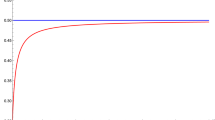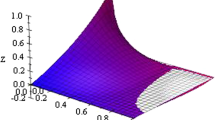Abstract
This paper models a rent-seeking contest which allows for the provision of third-party support. Support can be either provided by reducing the supported player’s cost of fighting or by increasing the ability to fight. I present and solve a rent-seeking contest which nests these two intervention mechanisms. Among others, I find that for identical intervention costs of the two mechanisms, the intervention mechanism becomes irrelevant for the outcome of the contest if the supported player’s cost ability parameter as well as the ability to fight are identical. Additionaly, the model endogenizes the third party’s choice of the applicable intervention mechanism. Among others, I find that different intervention mechanisms can lead to identical outcomes, despite different levels of fighting efforts.
Similar content being viewed by others
Notes
See also Hentschel (2022) on third-party intervention in a secessionist conflict with ability-increasing support.
It can be shown that the model’s main results are similar to the results when comparing cost-reducing and cost-increasing intervention mechanisms, applying the same methodological approach.
References
Amegashie JA (2014) Asymmetric information and third-party intervention in civil wars. Def Peace Econ 25(4):381–400
Amegashie JA, Kutsoati E (2007) (Non)intervention in intra-state conflicts. Eur J Political Econ 23(3):754–767
Baik KH, Kim I-G (1997) Delegation in contests. Eur J Political Econ 13(2):281–298
Chang Y-M, Potter J, Sanders S (2007) War and peace: third-party intervention in conflict. Eur J Political Econ 23(4):954–974
Chang Y-M, Sanders S (2009) Raising the cost of rebellion: the role of third-party intervention in intrastate conflict. Defence Peace Econ 20(3):149–169
Corchón L, Dahm M (2010) Foundations for contest success functions. Econ Theory 43(1):81–98
Epstein GS, Hefeker C (2003) Lobbying contests with alternative instruments. Econ Gov 4(1):81–89
Hentschel F (2022) Third-party intervention in secessions. Econ Gov 23(1):65–82
Münster J (2009) Group contest success functions. Econ Theory 41(2):345–357
Schoonbeek L (2007) Delegation with multiple instruments in a rent-seeking contest. Public Choice 131(4):453–464
Skaperdas S (1996) Contest success functions. Econ Theory 7(2):283–290
Author information
Authors and Affiliations
Corresponding author
Additional information
Publisher's Note
Springer Nature remains neutral with regard to jurisdictional claims in published maps and institutional affiliations.
Appendix
Appendix
1.1 Proof of Lemma 1
-
(i)
The solution to player 1’s optimization problem is
$$\begin{aligned} \dfrac{\partial U_{1}}{\partial f_{1}}=\dfrac{\partial p_{1}}{\partial f_{1}}\alpha V_{1}-\dfrac{1}{A^{c}_{1}+(1-I)s_{3}}=0 \\ \ \text {with} \\ \ f_{1}>0. \end{aligned}$$It can be shown that
$$\begin{aligned} \dfrac{\partial ^{2} U_{1}}{\partial ^{2} f_{1}}<0 \end{aligned}$$holds. Hence, the second-order condition of player 1’s maximization problem is satisfied. Using player 1’s first-order condition, his best response to player 2 gives two possible solutions:
$$\begin{aligned} BR_{1,1}=\sqrt{f_{2}\frac{[A^{c}_{1}+(1-I)s_{3}]}{\left( A^{f}_{1}+I s_{3}\right) }\alpha V_{1}}-\frac{f_{2}}{\left( A^{f}_{1}+I s_{3}\right) }, \end{aligned}$$and
$$\begin{aligned} BR_{1,2}=-\sqrt{f_{2}\frac{[A^{c}_{1}+(1-I)s_{3}]}{\left( A^{f}_{1}+I s_{3}\right) }\alpha V_{1}}-\frac{f_{2}}{\left( A^{f}_{1}+I s_{3}\right) }. \end{aligned}$$Player 1’s best response cannot be negative and hence, \(BR_{1,1}\) is the only possible solution. Solution \(BR_{1,1}\) is positive if condition
$$\begin{aligned} \alpha V_{1}[A^{c}_{1}+(1-I)s_{3}]>\frac{f_{2}}{\left( A^{f}_{1}+I s_{3}\right) } \end{aligned}$$holds, and \(BR_{1,1}=0\) otherwise.
-
(ii)
The solution to player 2’s optimization problem is
$$\begin{aligned} \dfrac{\partial U_{2}}{\partial f_{2}}=\dfrac{\partial (1-p_{1})}{\partial f_{2}}V_{2}-1=0 \\ \ \text {with} \\ \ f_{2}>0. \end{aligned}$$It can be shown that
$$\begin{aligned} \dfrac{\partial ^{2} U_{2}}{\partial ^{2} f_{2}}<0 \end{aligned}$$holds. Hence, the second-order condition of player 2’s maximization problem is satisfied. Using player 2’s first-order condition, his best response to player 1 gives two possible solutions:
$$\begin{aligned} BR_{2,1}=\sqrt{f_{1}\left( A^{f}_{1}+I s_{3}\right) V_{2}}-f_{1}\left( A^{f}_{1}+I s_{3}\right) , \end{aligned}$$and
$$\begin{aligned} BR_{2,2}=-\sqrt{f_{1}\left( A^{f}_{1}+I s_{3}\right) V_{2}}-f_{1}\left( A^{f}_{1}+I s_{3}\right) . \end{aligned}$$Player 2’s best response cannot be negative and hence, \(BR_{2,1}\) is the only possible solution. Solution \(BR_{2,1}\) is positive if condition
$$\begin{aligned} V_{2}>f_{1}\left( A^{f}_{1}+I s_{3}\right) \end{aligned}$$holds, and \(BR_{2,1}=0\) otherwise.
1.2 Proof of Corollary 1
-
(i)
Suppose \(I=1\) holds. The partial derivative of \(BR_{1}\) with respect to support \(s_{3}\) is:
$$\begin{aligned} \dfrac{\partial BR_{1}}{\partial s_{3}}=-\dfrac{1}{2}\sqrt{\dfrac{A^{f}_{1}+s_{3}}{f_{2}A^{c}_{1}\alpha V_{1}}}\dfrac{f_{2}A^{c}_{1}\alpha V_{1}}{\left( A^{f}_{1}+s_{3}\right) ^{2}}+\dfrac{f_{2}}{\left( A^{f}_{1}+s_{3}\right) ^{2}}. \end{aligned}$$It can be shown that \(\frac{\partial BR_{1}}{\partial s_{3}}>0\) holds if:
$$\begin{aligned} \dfrac{4f_{2}}{A^{c}_{1}\alpha V_{1}}>A^{f}_{1}+s_{3}. \end{aligned}$$The partial derivative of \(BR_{2}\) with respect to support \(s_{3}\) is:
$$\begin{aligned} \dfrac{\partial BR_{2}}{\partial s_{3}}=\dfrac{1}{2}\sqrt{\dfrac{f_{1}V_{2}}{A^{f}_{1}+s_{3}}}-f_{1}. \end{aligned}$$It can be shown that \(\frac{\partial BR_{2}}{\partial s_{3}}>0\) holds if:
$$\begin{aligned} \dfrac{V_{2}}{A^{f}_{1}+s_{3}}>4 f_{1}. \end{aligned}$$ -
(ii)
Suppose \(I=0\) holds. The partial derivative of \(BR_{1}\) with respect to support \(s_{3}\) is:
$$\begin{aligned} \dfrac{\partial BR_{1}}{\partial s_{3}}=\dfrac{1}{2}\sqrt{\dfrac{f_{2}\alpha V_{1}}{A^{f}_{1}\left( A^{c}_{1}+s_{3}\right) }}. \end{aligned}$$It can be shown that \(\frac{\partial BR_{1}}{\partial s_{3}}>0\) holds. The partial derivative of \(BR_{2}\) with respect to support \(s_{3}\) is:
$$\begin{aligned} \dfrac{\partial BR_{2}}{\partial s_{3}}=0. \end{aligned}$$
1.3 Proof of Lemma 2
-
(i)
Player 1 takes player 2’s best response \(BR_{2}\) as given, and chooses his optimal behavior in the subgame, i.e., \(f_{1}=BR_{1}[BR_{2},s_{3}]\). Using the players’ best response functions in Lemma 1 and Definition 1, player 1’s optimal behavior, given player 2’s optimal response to player 1’s behavior is
$$\begin{aligned} f_{1}= \dfrac{V_{2}}{A^{f}_{1}+I s_{3}} \left[ \dfrac{\left( A^{f}_{1} A^{c}_{1}+\Delta s_{3}\right) \alpha V_{1}}{\left( A^{f}_{1} A^{c}_{1}+\Delta s_{3}\right) \alpha V_{1} + V_{2} }\right] ^{2} \end{aligned}$$In a next step, one has to show that player 1’s best response to player 2’s equilibrium behavior is positive, i.e., one has to show that \(BR_{1}[f_{2}]>0\) holds. Using player 2’s optimal behavior in Lemma 2, player 1’s best response in Lemma 1 is positive if the following condition holds:
$$\begin{aligned} \alpha V_{1}[A^{c}_{1}+(1-I)s_{3}]>\frac{f_{2}}{\left( A^{f}_{1}+I s_{3}\right) }. \end{aligned}$$Rearranging, this condition holds for
$$\begin{aligned} \left( A^{f}_{1} A^{c}_{1}+\Delta s_{3}\right) \alpha V_{1}>0, \end{aligned}$$which is satisfied. Thus, player 1’s best response to player 2’s equilibrium behavior is positive.
-
(ii)
Player 2 takes player 1’s best response \(BR_{1}\) as given, and chooses his optimal behavior in the subgame, i.e., \(f_{2}=BR_{2}[BR_{1},s_{3}]\). Using the players’ best response functions in Lemma 1 and Definition 1, player 2’s optimal behavior, given player 1’s optimal response to player 2’s behavior is
$$\begin{aligned} f_{2}= \dfrac{\alpha V_{1}}{A^{f}_{1} A^{c}_{1}+\Delta s_{3}} \left[ \dfrac{\left( A^{f}_{1}A^{c}_{1}+\Delta s_{3}\right) V_{2}}{\left( A^{f}_{1}A^{c}_{1}+\Delta s_{3}\right) \alpha V_{1} + V_{2} }\right] ^{2}. \end{aligned}$$In a next step, one has to show that player 2’s best response to player 1’s equilibrium behavior is positive, i.e., one has to show that \(BR_{2}[f_{1}]>0\) holds. Using player 1’s optimal behavior in Lemma 2, player 2’s best response in Lemma 1 is positive if the following condition holds:
$$\begin{aligned} V_{2}>f_{1}(A^{f}_{1}+I s_{3}) \end{aligned}$$Rearranging, this condition holds for
$$\begin{aligned} V_{2}>0, \end{aligned}$$which is satisfied. Thus, player 2’s best response to player 1’s equilibrium behavior is positive.
-
(iii)
Next, one has to check whether \(f_{1}=0\) and \(f_{2}=0\) can be an equilibrium in the subgame. Suppose player 1 chooses \(f_{1}=0\), while player 2 chooses \(f_{2}=0\). In this case, player 2 can turn himself into the winner of the contest by investing a small amount of resources. Player 1 knows about player 2’s incentive to invest a small amount of resources in the contest. Thus, he has an incentive to deviate from \(f_{1}=0\). The same intuition holds if player 2 chooses \(f_{2}=0\) and player 1 deviates from choosing \(f_{1}=0\). Thus, \(f_{1}=0\) and \(f_{2}=0\) cannot be an equilibrium in the subgame.
1.4 Proof of Lemma 3
-
(i)
Player 3 takes the optimal behavior of players 1 and 2 in Lemma 2 as given, and chooses his optimal behavior in the first stage. Using player 3’s first-order condition, the optimal behavior of players 1 and 2 in Lemma 2, and Definition 3, player 1’s optimal behavior is:
$$\begin{aligned} s_{3}=\kappa _{3}-\dfrac{A^{f}_{1}A^{c}_{1}}{\Delta }. \end{aligned}$$It can be shown that
$$\begin{aligned} \dfrac{\partial ^{2} U_{3}}{\partial ^{2} s_{3}}<0 \end{aligned}$$holds. Hence, the second-order condition of player 3’s maximization problem is satisfied.
-
(ii)
In the subgame, players 1 and 2 choose their optimal behavior given the provided support by player 3 in the first stage. Thus, in the next step, one has to show that player 1’s best response to player 2’s equilibrium behavior in the second stage is positive given the optimal behavior of player 3, i.e., one has to show that \(BR_{1}(f_{2},s_{3})>0\) holds. Using Lemma 1 and Proposition 1, one can show that \(BR_{1}(f_{2},s_{3})>0\) holds. Furthermore, one has to show that player 2’s best response to player 1’s equilibrium behavior in the second stage is positive given the optimal behavior of player 3, i.e., one has to show that \(BR_{2}(f_{1},s_{3})>0\) holds. Using Lemma 1 and Proposition 1, one can show that \(BR_{2}(f_{1},s_{3})>0\) holds.
-
(iii)
Using \(s_{3}\) and Lemma 2 gives the equilibrium behavior of players 1 and 2, i.e.,
$$\begin{aligned} f_{1}=\alpha V_{1} \biggl \lbrace A^{c}_{1} +(1-I) \biggl [ \kappa _{3}- \dfrac{A^{f}_{1}A^{c}_{1}}{\Delta } \biggr ] \biggr \rbrace \dfrac{\alpha V_{1}V_{2}\Delta \kappa _{3}}{(V_{2}+\alpha V_{1}\Delta \kappa _{3})^{2}}, \end{aligned}$$and
$$\begin{aligned} f_{2}=V_{2} \dfrac{\alpha V_{1}V_{2}\Delta \kappa _{3}}{(V_{2}+\alpha V_{1}\Delta \kappa _{3})^{2}}. \end{aligned}$$
1.5 Proof of Lemma 4
Using Lemma 3, it can be shown that \(p_{1,I=1}>p_{1,I=0}\) if:
Rearranging, one can show that \(p_{1,I=1}>p_{1,I=0}\) if:
1.6 Proof of Lemma 5
Assuming \(A^{c}_{1}=A^{f}_{1} C\left( A^{f}_{1}\right)\), and using Lemma 3, it can be shown that \(s_{3,I=0}>s_{3,I=1}\) if:
Using \(A^{c}_{1}=A^{f}_{1} C\left( A^{f}_{1}\right)\), and \(\kappa _{3,I=1}=\frac{1}{C(A^{f}_{1})}\kappa _{3,I=0}\), one can show that \(s_{3,I=0}>s_{3,I=1}\) if:
Rearranging, one can show that \(s_{3,I=0}>s_{3,I=1}\) if:
1.7 Proof of Lemma 6
Using Lemma 3, it can be shown that \(s_{3,I=0}=\sqrt{\frac{V_{2}(1-\alpha )}{\alpha A^{f}_{1}}}-\frac{V_{2}}{\alpha V_{1} A^{f}_{1}}-A^{c}_{1}\) and \(s_{3,I=1}=\sqrt{\frac{V_{2}(1-\alpha )}{C(A^{f}_{1})\alpha A^{c}_{1}}}-\frac{V_{2}}{\alpha V_{1} A^{c}_{1}}-A^{f}_{1}\). Rearranging and using \(C(A^{f}_{1})=\frac{A^{c}_{1}}{A^{f}_{1}}\), one can show that \(s_{3,I=0}=s_{3,I=1}C(A^{f}_{1})\).
1.8 Proof of Proposition 1
Player 3’s prefers intervention mechanism \(I=1\) over \(I=0\) if \(U_{3,I=1}^{*}>U_{3,I=0}^{*}\), which can be rewritten as:
Rearranging, this condition can be rewritten as:
The term \(C(A^{f}_{1}) s_{3,I=1}^{*}-s_{3,I=0}^{*}\) can be rewritten as \(C(A^{f}_{1}) [ \kappa _{3,I=1}-A^{f}_{1} ]- [\kappa _{3,I=0}-A^{c}_{1}]\). It can be shown that \(\kappa _{3,I=1}=\frac{1}{C(A^{f}_{1})}\kappa _{3,I=0}\), i.e., the term \(C(A^{f}_{1}) s_{3,I=1}^{*}-s_{3,I=0}^{*}\) can be rewritten as \(A^{c}_{1}-C(A^{f}_{1}) A^{f}_{1}\). Thus, using \(p_{1,I=1}^{*}=\sqrt{\frac{V_{2}}{A^{f}_{1}\alpha V_{1}^{2}(1-\alpha )}}\) and \(p_{1,I=0}^{*}=\sqrt{\frac{V_{2}C(A^{f}_{1})}{A^{c}_{1}\alpha V_{1}^{2}(1-\alpha )}}\), one can rewrite the above condition accordingly:
Using Definition 4, player 3 chooses \(I=1\) if \(\Phi >0\), \(I=0\) if \(\Phi <0\), and player 3 is indifferent between the two mechanisms if \(\Phi =0\). Using Lemma 3, the equilibrium choices of all three players can be derived for the realizations of \(\Phi\).
1.9 Proof of Corollary 2
Suppose condition \(A^{c}_{1}=A^{f}_{1} C(A^{f}_{1})\) holds. Using Proposition 1, player 3 is indifferent between the two intervention mechanisms if the following condition is satisfied:
Using Lemma 4 and rearranging, this condition is:
Using \(A^{c}_{1}=A^{f}_{1} C(A^{f}_{1})\) and rearranging, this condition yields:
Hence, one can show that \(U_{3,I=0}^{*}=U_{3,I=1}^{*}\) holds if condition \(A^{c}_{1}=A^{f}_{1} C(A^{f}_{1})\) is satisfied.
1.10 Proof of Proposition 2
Suppose \(A^{c}_{1}=A^{f}_{1} C(A^{f}_{1})\) holds. Using Proposition 1, the aggregated efforts \(F^{*}=f_{1}^{*}+f_{2}^{*}\) in the case of \(I=0\) are larger than in the case of \(I=1\) if the following condition is satisfied:
Using condition \(A^{c}_{1}=A^{f}_{1} C(A^{f}_{1})\), one can show that \(A^{f}_{1} \kappa _{3,I=0} = A^{c}_{1} \kappa _{3,I=1}\) holds. Using \(A^{f}_{1} \kappa _{3,I=0} = A^{c}_{1} \kappa _{3,I=1}\), and rearranging, one can show that the aggregated efforts \(F^{*}=f_{1}^{*}+f_{2}^{*}\) in the case of \(I=0\) are larger than in the case of \(I=1\) if \(\kappa _{3,I=0}>A^{c}_{1}\) holds.
1.11 Proof of Proposition 3
Suppose \(A^{c}_{1}=A^{f}_{1} C(A^{f}_{1})\) holds.
-
(i)
From Proposition 2 follows \(U_{3,I=0}^{*}=U_{3,I=1}^{*}\).
-
(ii)
Using Lemma 4, \(U_{1,I=0}^{*}=U_{1,I=1}^{*}\) holds if the following condition is satisfied:
$$\begin{aligned} \dfrac{f_{1,I=1}^{*}}{A^{c}_{1}}=\dfrac{f_{1,I=0}^{*}}{A^{c}_{1}+s_{3,I=0}^{*}}. \end{aligned}$$Using condition \(A^{c}_{1}=A^{f}_{1} C(A^{f}_{1})\), one can show that \(A^{f}_{1} \kappa _{3,I=0} = A^{c}_{1}\kappa _{3,I=1}\) holds. Using \(A^{f}_{1} \kappa _{3,I=0} = A^{c}_{1}\kappa _{3,I=1}\), and Proposition 1, one can show that \(U_{1,I=0}^{*}=U_{1,I=1}^{*}\) is satisfied if condition \(A^{c}_{1}=A^{f}_{1} C(A^{f}_{1})\) holds.
-
(iii)
Using Lemma 4, \(U_{2,I=0}^{*}=U_{2,I=1}^{*}\) holds if the following condition is satisfied:
$$\begin{aligned} f_{2,I=1}^{*}=f_{2,I=0}^{*}. \end{aligned}$$Using \(A^{f}_{1} \kappa _{3,I=0} = A^{c}_{1}\kappa _{3,I=1}\), and Proposition 1, one can show that \(U_{2,I=0}^{*}=U_{2,I=1}^{*}\) is satisfied if condition \(A^{c}_{1}=A^{f}_{1} C(A^{f}_{1})\) holds.
Rights and permissions
Springer Nature or its licensor (e.g. a society or other partner) holds exclusive rights to this article under a publishing agreement with the author(s) or other rightsholder(s); author self-archiving of the accepted manuscript version of this article is solely governed by the terms of such publishing agreement and applicable law.
About this article
Cite this article
Hentschel, F. Alternative intervention mechanisms in rent-seeking contests. Econ Gov 24, 453–471 (2023). https://doi.org/10.1007/s10101-023-00298-1
Received:
Accepted:
Published:
Issue Date:
DOI: https://doi.org/10.1007/s10101-023-00298-1




